LEA supports effective dispute resolution by developing the process-design together with local stakeholders. Mediation methods can be used for the conflict resolution process.
To support the development of a good solution, a topological chart is made on basis of the model of a hexagram. The hexagram is a useful model to gather and structure relevant information that can contributed to an informed and well reasoned decision. Each of the six positions is related to a task to gather relevant knowledge about:
1: Law and the intentions of the legislator (historical arguments)
2: Facts: ecological, social and economical (contextual factual arguments)
3. Comparable cases (comparative and systematic arguments)
4. Policy context and debates (teleological arguments)
5. Perceptions of justice (fundamental values arguments and local perceptions of justice)
6. Local perspectives (contextual normative arguments)
For each topic, the complexity and plurality of the information can demand that an additional hexagon is required to structure and hyve information. A maximal completed chart will have the following structure:

The hexagram can be used to make the choices transparent and to develop with help of the interpretation methods a well-argued decision. Aside, the model can also be used to create decision-making power.
An example of an approach to organise decision-making power is the following:
To each of the six points a person is appointed. This means that in total 6 people are involved. each oen represents his or her position and has a role as Judge or as implementor. There are thus two teams. Position 1, 3 and 5 are Team 1 and primarily concerned with matters of principle and the task of judging. Position 2,4 and 6 are Team 2 primarily concerned with facts, context and making things happen.
Each team is set up in the same. (Assuming that the conflict has two main parties) the positions are assigned as follows. One person is appointed by party A and one person is appointed by party B. The two representatives appoint together the third person.
The task of Team 1 is to decide on the case. The task of Team 2 is to make sure that the solution is implemented. To resolve a conflict both are equally important.
